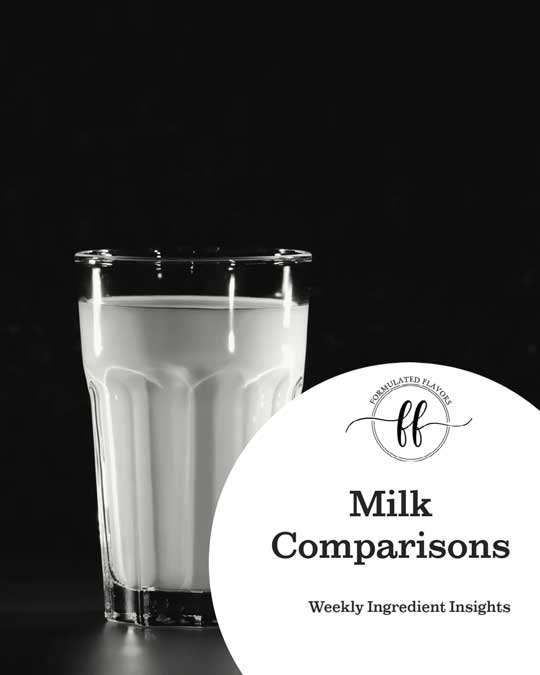A Comparison of Popular Milk Types
It feels that there is a milk made from almost anything, from peas to oats to cashews, there is a milk out there that probably perfectly fits anyone’s dietary needs. We aren’t huge (plain) milk drinkers, but given milk’s widespread uses we almost always have a type of milk on hand (usually almond milk). Since we are pretty active in the kitchen, though, we found ourselves just using the milk we had on hand as opposed to a specific kind, which begged the question: Does it matter if you swap in different forms of milk? We decided to compare some milks to answer it.
Milk is mostly water, regardless of where it comes from, just with a touch of creaminess that makes it feel like milk. However, even whole milk is only slightly denser than just typical water. To better understand this, take the conversion from volume (ml) to g (mass / weight). Water is a one to one conversion (by design), meaning 1ml of water is equal to 1g of water. For whole milk, the fattiest of regular dairy milk, 1ml of milk is equal to 1.04g of milk and for skimmed milk, the least fatty, 1ml is equal to 1.03g. So, under the notion that even the fattiest and least fatty milks have very close ml to g conversions, this allows us to compare some fat and protein compositions between some major types of milk.
The table below is a milk comparison chart, designed to put the fat and protein composition side by side. The brand for regular milk has been left off, as it should not be too different between them. For all of the milk types there are definitely many different brands, and all will have slightly different characteristics. For simplicity, Silk was the main brand used since it has many different milk types. There are extras for oat milk and almond milk, but only to demonstrate the similarity to the other brand to build confidence nothing would change drastically by brand.
|
Brand |
Milk Type | Fat % | Protein % |
|
Dairy – No Brand |
Whole | 3.2% | 3.2% |
|
Dairy – No Brand |
Reduced Fat | 2.0% | 3.3% |
|
Dairy – No Brand |
Low-fat | 1.0% | 3.3% |
|
Dairy – No Brand |
Skimmed | 0.1% | 3.4% |
|
Ripple |
Pea | 1.8% | 3.3% |
|
Silk |
Almond | 1.0% | 0.4% |
| Silk | Coconut | 1.8% |
0.0% |
| Oatly | Oat | 1.5% |
1.0% |
| Silk | Cashew | 0.8% |
0.4% |
| Silk | Soy | 1.8% |
3.3% |
| Silk | Oat Extra Creamy | 2.0% |
0.4% |
| Dream Plant Based | Rice | 1.0% |
0.4% |
| Almond Breeze | Almond | 1.0% |
0.4% |
Whole milk takes the fat % win at the standard right around 3.25%. This could depend slightly on brand and milk source, but dairy milk appears to have the highest fat content. Most other milks appear to be more inline with reduced or low-fat dairy milk. This should make sense, as most plant-based milks are attempting to be a healthy alternative to milk and are thus trying to not be high in fat. However, almost none of the basic or original versions venture much below 1% fat, which would bring it closer to skimmed milk.
In addition to fat, it is evident that protein levels vary as well. Protein is particularly important to look at when considering milk in one of its classic forms: cereal. Not so much for flavor, but for the overall benefit of drinking milk at all. Switching from dairy to coconut milk might save some calories but could come at the cost of feeling full. Protein does fluctuate more than the fat content and could be worth keeping in mind as you interchange milks around.
One final piece to watch out for is sugar. Dairy milk has sugar in it while most plant-based typically add it in. Since most brands have a large array of product-offerings they have been excluded from this list. However, just like you must watch sodium leakage in a recipe, consider sugar leakage as well. Make sure you know the source of sugar when making food and if you don’t need a plant-based milk to be sweet in of itself, perhaps it would be best to go for the sugar-free versions of them.
So how does this relate to usage? Assuming flavor does not matter to you, but rather the added creaminess or fat from the milk in a recipe, it appears that milks are all roughly interchangeable. dropping 1.5% to substitute whole milk for something dairy-free should not impact a recipe too drastically. However, half and half and heavy whipping cream, which can have up to 35% fat content, are obviously a whole different level and a regular milk would not provide the necessary creaminess in any form. Different milks have different compositions, paying attention to this before usage can allow you to use them to their full advantage and adjust as necessary.


Great information, I always learn something new in your posts!